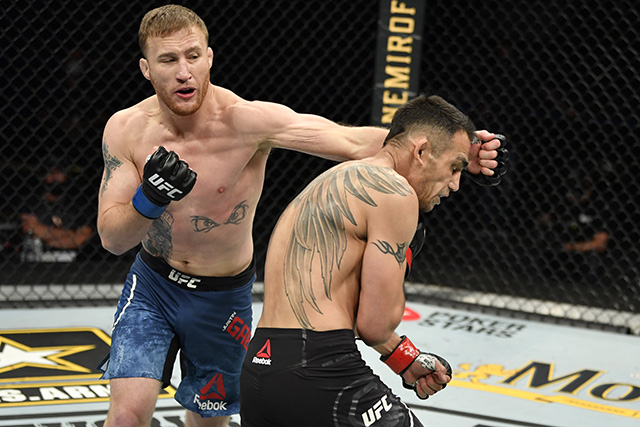Editor’s note: The views and opinions expressed below are those of the author and do not necessarily reflect the views of Sherdog.com, its affiliates and sponsors or its parent company, Evolve Media.
* * *
After nearly two months without mixed martial arts, the Ultimate Fighting Championship on May 9 made its return with an event that mostly lived up to fan expectations. The pay-per-view portion of UFC 249 saw four of the five scheduled bouts conclude inside the distance, and the Tony Ferguson-Justin Gaethje headliner resulted in thrills and chills, as “The Highlight” put an end to Ferguson’s historic 12-fight winning streak at 155 pounds. Meanwhile, Francis Ngannou finished his fourth consecutive bout inside a minute; Calvin Kattar brutally finished Jeremy Stephens; and Henry Cejudo stopped Dominick Cruz, only to promptly announce his retirement from the sport. It had all the makings of a classic MMA card, and that does not include the show Vicente Luque and Niko Price put on or Bryce Mitchell’s insane ground assault that was showcased on the undercard.
Not only did the card deliver in terms of action, but it crushed any preconceived notions financially, as well. According to the Sports Business Journal, UFC 249 sold over 700,000 buys, making it one of the most-watched events that did not feature Jon Jones or Conor McGregor. In an interview with Yahoo Sports, UFC President Dana White stated that the promotion “absolutely destroyed it” and that “It was a home run by every measure.” Based on the previous drawing power of Ferguson and Gaethje, UFC 249 exceeded expectations, some of which were way off the mark.
That doesn’t mean it was free of any controversy. On the eve of the event, it was announced that Ronaldo Souza and two of his cornermen had tested positive for COVID-19, raising concerns as to whether or not the card would continue as planned and what exposure others had to the virus. After the pay-per-view concluded, it was also revealed that fighters and media in attendance had to sign a controversial waiver, which forbid any in attendance to discuss the UFC’s COVID-19 testing protocols or health operations surrounding UFC 249. Failure to comply with the agreement could result in fighters’ purses being revoked or litigation against participants. It prompted a rebuke from the Mixed Martial Arts Journalists Association.
Despite those hiccups, however, it’s hard to argue that UFC 249 was anything but a success from a business perspective. After being forced to postpone the event due to pressure from the company’s business partners and the California government, UFC 249 delivered in spades for the Las Vegas-based organization, taking advantage of the lack of live sporting options to bring in revenue that may have been otherwise unattainable given the fighters being featured on the card. Given the dire financial situation of UFC parent company Endeavor and ESPN being starved for content, the promotion’s business partners should be singing the UFC’s praises when it comes to the decision to host an event during a global pandemic.
The rest of the sporting world might end up thanking the UFC, as well. White has stated that multiple states and sports leagues have reached out to him regarding the process for proceeding during the current health crisis. He has also indicated that he is willing to share the 30-page document he submitted to the state of Florida on what procedures the promotion put in place in order to pull off the pay-per-view event safely, stating that he hoped “live sports would be back very soon.” Should other leagues such as MLB, the NBA and the NFL be able to transition the UFC’s COVID-19 event blueprint into their own organizations, sports as we know it may return, albeit with certain precautionary changes.
UFC 249 was always a high-risk, high-reward scenario for the Ultimate Fighting Championship, and it is clear that the promotion’s gamble has paid off. It’s unlikely that there will be any significant fallout from the organization’s waiver or Souza’s positive test results in the short-term, and the company has begun the process of catching up on contractual obligations so it can receive an estimated $750 million in media rights from broadcast partner ESPN. The May 9 card also garnered attention from a number of celebrities, which most likely attracted more casual viewers than usual and could hypothetically help make stars out of fighters like Gaethje. Should UFC cards continue to deliver excitement while the rest of the sporting world remains paused, viewership for MMA as a whole could grow simply due to the lack of competitors.
Whether or not the next events will keep viewers satiated remains to be seen, but one could expect a bump in viewership and ESPN+ subscribers for the month of May at least. As states begin to reopen and sports are given permission to resume, it seems unlikely that the UFC will be the only show in town for much longer, making the spike in MMA viewership short-lived. It’s hard to say what the future holds for sports, let alone the world, in the coming months as countries continue to adapt to COVID-19, but when it comes to past decisions, it’s clear that from a business standpoint the UFC made the right call with UFC 249.



